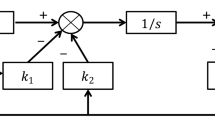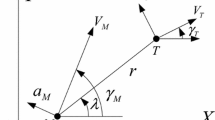Abstract
This paper investigates guidance scheme for missile with actuator failure and dynamics of autopilot. Firstly, considering first-order dynamics of autopilot, the guidance model with actuator failure is established. Secondly, an adaptive sliding mode fault-tolerant guidance law is designed on the basis of passive fault-tolerant technique and a novel nonsingular fast terminal sliding mode (NFTSM) manifold. Then, the adaptive algorithm with the feature of low-pass filter is proposed to ensure that adaptive parameters are bounded when the sliding mode is non-ideal. Finally, Lyapunov stability theory is adopted to prove that the states of closed-loop system are practical finite-time stability. Simulation results demonstrate the effectiveness and robustness of the proposed guidance strategy under the certain actuator failure.
Similar content being viewed by others
References
X. Wang and J. Wang, “Partial integrated guidance and control for missiles with three-dimensional impact angle constraints,” Journal Guidance Control Dynamics, vol. 37, no. 2, pp. 644–657, March 2014.
P. K. Menon and E. J. Ohlmeyer, “Integrated design of agile missile guidance and autopilot systems,” Control Engineering Practic, vol. 9, no. 10, pp. 1095–1106, October 2001.
T. Garai and S. Mukhopadhyay, “Closed-form solution of pure proportional navigation with tracker-in-loop,” Proc. of the American Control Conference, pp. 2352–2357, June, 2008
S. Y. Hayoun, M. Weiss, and T. Shima, “A mixed L2/Lα differential game approach to pursuit-evasion guidance,” IEEE Trans. on Aerospace and Electronic Systems, vol. 52, no. 6, pp. 2775–2788, December 2016.
N. Lechevin and C. A. Rabbath, “Robust discrete-time proportional derivative navigation guidance,” Journal of Guidance, Control, and Dynamics, vol. 35, no. 3, pp. 1007–1013, May 2012.
J. H. Song, S. M. Song, and H. B. Zhou, “Adaptive nonsingular fast terminal sliding mode guidance law with impact angle constraints,” International Journal of Control, Automation and Systems, vol. 14, no. 1, pp. 99–114, February 2016.
H. B. Zhou, S. M. Song, and J. H. Song, “Design of sliding mode guidance law with dynamic delay and impact angle constraint,” International Journal of Control, Automation and Systems, vol. 15, no. 1, pp, 239–247, December 2017.
Q. Z. Zhang, Z. B. Wang, and F. Tao, “Optimal guidance law design for impact with terminal angle of attack constraint,” Optik-International Journal for Light and Electron Optics, vol. 125, no. 1, pp. 243–251, Jnuary 2014.
J. Dalton and S. Balakrishnan, “A neighboring optimal adaptive critic for missile guidance,” Mathematical and Computer Modelling, vol. 23, no. 1, pp. 175–188, January 1996.
C. F. Lin, E. Ohlmeyer, J. E. Bibel, and S. Malyevac, “Optimal design of integrated missile guidance and control,” Proc. of World Aviation Conference, pp. 1–11, September 1998.
T. Shima and O. Golan, “Linear quadratic differential games fuidance law for dual controlled missiles,” IEEE Trans. on Aerospace and Electronic Systems, vol. 43, no. 3, pp. 834–842, August 2007.
D. Zhou, C. Mu, and T. Shen, “Robust guidance law with L2 gain performance,” Trans. of the Japan Society for Aeronautical and Space Sciences, vol. 44, no. 144, pp. 82–88, January 2001.
T. Shima, “Intercept-angle guidance,” Journal of Guidance, Control, and Dynamics, vol. 34, no. 2, pp. 484–492, March 2011.
S. Rao and D. Ghose, “Terminal impact angle constrained guidance law using variable structure systems theory,” IEEE Trans. on Control Systems Technology, vol. 21, no. 6, pp. 2350–2359, August. 2013.
S. R. Kumar, S. Rao, and D. Ghose, “Nonsingular terminal sliding mode guidance with impact angle constraints,” Journal of Guidance, Control, and Dynamics, vol. 37, no. 4, pp. 1114–11130, Febuary 2014.
W. X. She, J. Zhou, and F. Q. Zhou, “An adaptive variable structure guidance law considering missile’s dynamics of autopilot,” Journal of Astronautics, vol. 24, no. 3, pp. 245–249, October 2003.
D. Chwa and J. Y. Choi, “Adaptive nonlinear guidance law considering control loop dynamics,” IEEE Trans. on Aerospace and Electronic Systems, vol. 39, no. 4, pp. 1134–1143, Novermber 2003.
S. Sun, D. Zhou, and W. Hou, “A guidance law with finite time convergence accounting for autopilot lag,” Aerospace Science and Technology, vol. 25, no. 1, pp. 132–137, March 2013.
S. He, J. Wang, and W. Wang, “A novel sliding mode guidance law without line-of-sight angular rate information accounting for autopilot lag,” International Journal of Systems Science, vol. 48, no. 4, pp. 1–11, September 2017.
S. He, D. Lin, and J. Wang, “Robust terminal angle constraint guidance law with autopilot lag for intercepting maneuvering targets.,” Nonlinear Dynamics, vol. 81, no. 1, pp. 881–892, July 2015.
Z. X. Zhang, S. H. Li, and S. Luo, “Composite guidance law based on sliding mode control with impact angle constraint and autopilot lag,” Trans. of the Institute of Measurement and Control, vol. 35, no. 6, pp. 764–776, August 2013.
W. Wang, S. Xiong, S. Wang, S. Song, and C. Lai, “Three dimensional impact angle constrained integrated guidance and control for missiles with input saturation and actuator fault,” Aerospace Science and Technology, vol. 53, pp. 169–187, June 2016.
F. Liao, K. H. Yang, and H. B. Ji, “Adaptive integrated guidance and control with actuator failures based on back-stepping and input-to-state stability,” Proceedings of Chinese Guidance, Navigation and Control Conference, pp. 49–54, January 2014.
M. F. Jegarkandi, A. Ashrafifar, and R. Mohsenipour, “Adaptive integrated guidance and fault tolerant control using backstepping and sliding mode,” International Journal of Aerospace Engineering, vol. 6, pp. 1–7, November 2015.
L. Fei and J. Haibo, “Guidance law with input constrains and actuator failures,” Asian Journal of Control, vol. 18, no. 3, pp. 1165–1172, August 2016.
J. H. Song and S. M. Song, “Three-dimensional guidance law based on adaptive integral sliding mode control,” Chinese Journal of Aeronautics, vol. 29, pp. 202–214, January 2016.
M. D. Tran and H. J. Kang, “Nonsingular terminal sliding mode control of uncertain second-order nonlinear systems,” Mathematical Problems in Engineering, vol. 2, pp. 1–8, October 2015.
Author information
Authors and Affiliations
Corresponding author
Additional information
Recommended by Associate Editor Chang Kyung Ryoo under the direction of Editor Duk-Sun Shim. This work was supported by Natural Science Foundation of Heilongjiang Province of China (Grant No. F2018024) and Fundamental Research Fund for Heilongjiang Provincial Universities of China (Grant No. HDJCCX-201622).
Guiying Li received her B.Sc. degree from the Harbin Institute of Technology, Harbin, China, in 1999, and her M.Sc. degree form Northeast Forest University in 2006. Since 2006, she has been with School of Mechanical and Electrical Engineering, Heilongjiang University, where she is currently an Electrical Engineer. Her main research interests include guidance and control, intelligent control, and system identification.
Zhigang Yu received his M.Sc. degree in Control Theory and control Engineering form Northeast Forest University, Harbin, China, in 2003, and his Ph.D. degree in Control Science and Engineering from the Harbin Institute of Technology, Harbin, China, in 2007. Since 2007, he has been with School of Electrical Engineering, Heilongjiang University, where he is currently an Associate Professor. His main research interests include nonlinear system robust control, and intelligent control.
Zhongxian Wang was born in Heilongjiang Province, China, in 1982. He received his B.S. degree in electrical engineering from Harbin University of Science and Technology, Harbin, China, in 2004, and his M.S. degree in control and instrument engineering from Wonkwang University, Iksan, Korea, in 2007. He is currently a Senior Engineer in the School of Mechanical and Electrical Engineering at Heilongjiang University, Harbin, China. His research interests include high-frequency power conversion technique.
Rights and permissions
About this article
Cite this article
Li, G., Yu, Z. & Wang, Z. Three-dimensional Adaptive Sliding Mode Guidance Law for Missile with Autopilot Lag and Actuator Fault. Int. J. Control Autom. Syst. 17, 1369–1377 (2019). https://doi.org/10.1007/s12555-017-0731-9
Received:
Revised:
Accepted:
Published:
Issue Date:
DOI: https://doi.org/10.1007/s12555-017-0731-9




